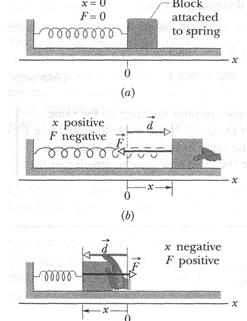Work Done by a Spring force
We next want to examine the work done on a particle-like object by a particular type of variable force - namely, a spring force,the force from a spring. Many forces in nature have the same mathematical form as the spring force. Thus, by examining this one force, you can gain an understanding of many others.

|
The Spring Force
Figure 7-lOa shows a spring in its relaxed state - that is, neither compressed nor extended. One end is fixed, and a particle-like object, say, a block, is attached to the other, free end. If we stretch the spring by pulling the block to the right as in Fig. 7- 10b, the spring pulls on the block toward the left. (Because a spring's force acts to restore the relaxed state, it is sometimes said to be a restoring force.) If we compress the spring by pushing the block to the left as in Fig. 7-10c, the spring now pushes on the block toward the right.
To a good approximation for many springs, the force  from a spring is proportional to the displacement
from a spring is proportional to the displacement  of the free end from its position when the spring is in the relaxed state. The spring force is given by
of the free end from its position when the spring is in the relaxed state. The spring force is given by
 (Hooke's law), (7-20)
(Hooke's law), (7-20)
which is known as Hooke's lawafter Robert Hooke, an English scientist of the late 1600s. The minus sign in Eq. 7-20 indicates that the spring force is always opposite in direction from the displacement of the free end. The constant  is called the spring constant(or force constant)and is a measure of the stiffness of the spring. The larger
is called the spring constant(or force constant)and is a measure of the stiffness of the spring. The larger  is, the stiffer the spring; that is, the stronger will be its pull or push for a given displacement. The SI unit for
is, the stiffer the spring; that is, the stronger will be its pull or push for a given displacement. The SI unit for  is the newton per meter.
is the newton per meter.
In Fig. 7-10 an  axis has been placed parallel to the length of a spring, with the origin (
axis has been placed parallel to the length of a spring, with the origin (  ) at the position of the free end when the spring is in its relaxed state. For this common arrangement, we can write Eq. 7-20 as
) at the position of the free end when the spring is in its relaxed state. For this common arrangement, we can write Eq. 7-20 as
 (Hooke's law), (7-21)
(Hooke's law), (7-21)
 If
If  is positive (the spring is stretched toward the right on the
is positive (the spring is stretched toward the right on the  axis), then
axis), then  is negative (it is a pull toward the left). If
is negative (it is a pull toward the left). If  is negative (the spring is compressed toward the left), then
is negative (the spring is compressed toward the left), then  is positive (it is a push toward the right).
is positive (it is a push toward the right).
Note that a spring force is a variable force because its magnitude and direction depend on the position  of the free end;
of the free end;  can be symbolized as
can be symbolized as  . Also note that Hooke's law is a linear relationship between
. Also note that Hooke's law is a linear relationship between  and
and  .
.
Дата добавления: 2015-06-17; просмотров: 840;
